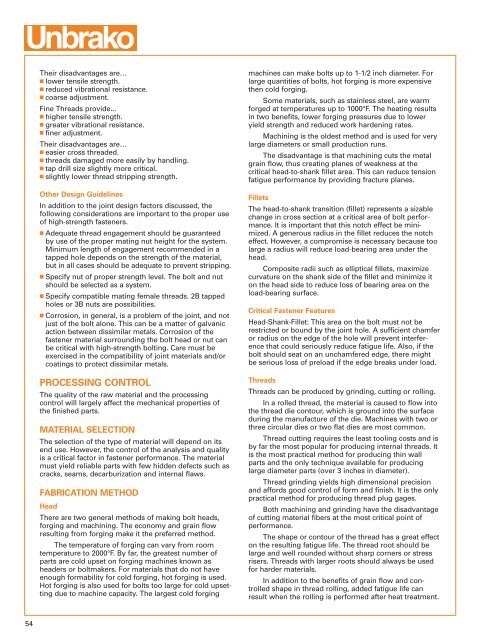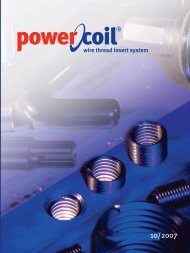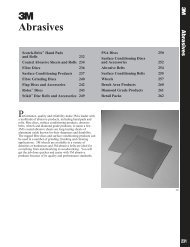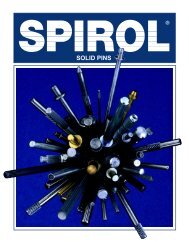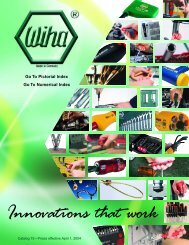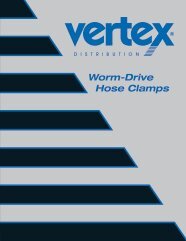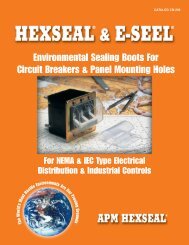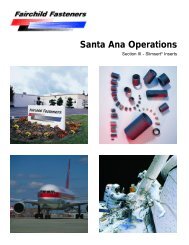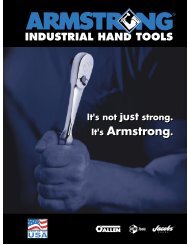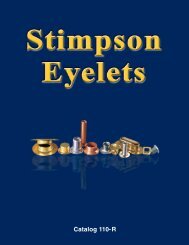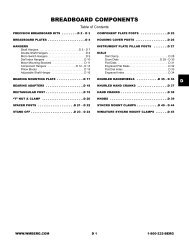91430 SPS cover edited - Electronic Fasteners Inc
91430 SPS cover edited - Electronic Fasteners Inc
91430 SPS cover edited - Electronic Fasteners Inc
Create successful ePaper yourself
Turn your PDF publications into a flip-book with our unique Google optimized e-Paper software.
Their disadvantages are… lower tensile strength. reduced vibrational resistance. coarse adjustment.Fine Threads provide... higher tensile strength. greater vibrational resistance. finer adjustment.Their disadvantages are… easier cross threaded. threads damaged more easily by handling. tap drill size slightly more critical. slightly lower thread stripping strength.Other Design GuidelinesIn addition to the joint design factors discussed, thefollowing considerations are important to the proper useof high-strength fasteners. Adequate thread engagement should be guaranteedby use of the proper mating nut height for the system.Minimum length of engagement recommended in atapped hole depends on the strength of the material,but in all cases should be adequate to prevent stripping. Specify nut of proper strength level. The bolt and nutshould be selected as a system. Specify compatible mating female threads. 2B tappedholes or 3B nuts are possibilities. Corrosion, in general, is a problem of the joint, and notjust of the bolt alone. This can be a matter of galvanicaction between dissimilar metals. Corrosion of thefastener material surrounding the bolt head or nut canbe critical with high-strength bolting. Care must beexercised in the compatibility of joint materials and/orcoatings to protect dissimilar metals.PROCESSING CONTROLThe quality of the raw material and the processingcontrol will largely affect the mechanical properties ofthe finished parts.MATERIAL SELECTIONThe selection of the type of material will depend on itsend use. However, the control of the analysis and qualityis a critical factor in fastener performance. The materialmust yield reliable parts with few hidden defects such ascracks, seams, decarburization and internal flaws.FABRICATION METHODHeadThere are two general methods of making bolt heads,forging and machining. The economy and grain flowresulting from forging make it the preferred method.The temperature of forging can vary from roomtemperature to 2000°F. By far, the greatest number ofparts are cold upset on forging machines known asheaders or boltmakers. For materials that do not haveenough formability for cold forging, hot forging is used.Hot forging is also used for bolts too large for cold upsettingdue to machine capacity. The largest cold forgingmachines can make bolts up to 1-1/2 inch diameter. Forlarge quantities of bolts, hot forging is more expensivethen cold forging.Some materials, such as stainless steel, are warmforged at temperatures up to 1000°F. The heating resultsin two benefits, lower forging pressures due to loweryield strength and reduced work hardening rates.Machining is the oldest method and is used for verylarge diameters or small production runs.The disadvantage is that machining cuts the metalgrain flow, thus creating planes of weakness at thecritical head-to-shank fillet area. This can reduce tensionfatigue performance by providing fracture planes.FilletsThe head-to-shank transition (fillet) represents a sizablechange in cross section at a critical area of bolt performance.It is important that this notch effect be minimized.A generous radius in the fillet reduces the notcheffect. However, a compromise is necessary because toolarge a radius will reduce load-bearing area under thehead.Composite radii such as elliptical fillets, maximizecurvature on the shank side of the fillet and minimize iton the head side to reduce loss of bearing area on theload-bearing surface.Critical Fastener FeaturesHead-Shank-Fillet: This area on the bolt must not berestricted or bound by the joint hole. A sufficient chamferor radius on the edge of the hole will prevent interferencethat could seriously reduce fatigue life. Also, if thebolt should seat on an unchamfered edge, there mightbe serious loss of preload if the edge breaks under load.ThreadsThreads can be produced by grinding, cutting or rolling.In a rolled thread, the material is caused to flow intothe thread die contour, which is ground into the surfaceduring the manufacture of the die. Machines with two orthree circular dies or two flat dies are most common.Thread cutting requires the least tooling costs and isby far the most popular for producing internal threads. Itis the most practical method for producing thin wallparts and the only technique available for producinglarge diameter parts (over 3 inches in diameter).Thread grinding yields high dimensional precisionand affords good control of form and finish. It is the onlypractical method for producing thread plug gages.Both machining and grinding have the disadvantageof cutting material fibers at the most critical point ofperformance.The shape or contour of the thread has a great effecton the resulting fatigue life. The thread root should belarge and well rounded without sharp corners or stressrisers. Threads with larger roots should always be usedfor harder materials.In addition to the benefits of grain flow and controlledshape in thread rolling, added fatigue life canresult when the rolling is performed after heat treatment.54


